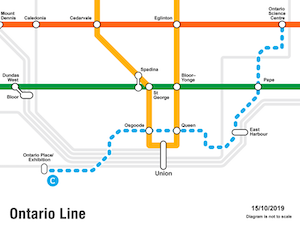Ontario Line project to be tendered as three RFQs
The Ontario Government announced on June 2 that it will tender the estimated $10.9-billion Ontario Line subway project in Toronto across three separate requests for qualifications (RFQs).
 Infrastructure Ontario (IO) and Metrolinx have already issued the first two RFQs for the project. One is for the rolling stock, systems, operations and maintenance for the entire 15.5-kilometre line; the other is for the southern civil work, stations and tunnel. The third, for the northern civil, stations and tunnel contract, is expected to be issued in 2022. The schedules for each will be aligned to allow for a single in-service date for the Ontario Line.
Infrastructure Ontario (IO) and Metrolinx have already issued the first two RFQs for the project. One is for the rolling stock, systems, operations and maintenance for the entire 15.5-kilometre line; the other is for the southern civil work, stations and tunnel. The third, for the northern civil, stations and tunnel contract, is expected to be issued in 2022. The schedules for each will be aligned to allow for a single in-service date for the Ontario Line.
The government said the approach will create separate contracts of manageable size and acceptable risk, encourage competition and participation from the market, and deliver the line at the best value for taxpayers.
"Our government is taking historic steps to expand subway service and reduce traffic congestion across the GTA," said Transportation Minister Caroline Mulroney. "By issuing these first RFQs we are one step closer to realizing our transit vision and helping to generate economic activity and create tens of thousands of jobs as the province recovers from COVID-19."
The Ontario Line is a 15.5-kilometre stand-alone rapid transit line that will connect the Ontario Science Centre to Exhibition/Ontario Place. The project was announced in April 2019 as part of a four-project transit package for the Greater Toronto and Hamilton Area. The projects are expected to be worth a combined total of nearly $30 billion.
The Ontario Line will run from Exhibition/Ontario Place to the Ontario Science Centre in downtown Toronto. Current plans call for 15 potential stations, including 17 new multi-modal connections to GO Transit, existing TTC subway stations and streetcar lines, and the Eglinton Crosstown Light Rail Transit line.
Over half of the route is planned to run underground through new tunnels. The remainder will run along elevated and at-grade rail corridor sections of track.
"The Ontario Line is one of the most significant transit infrastructure projects for Ontario in a generation," said Infrastructure Minister Laurie Scott. "Moving forward with these procurement contracts signals the government remains committed to building much needed transit infrastructure to reduce congestion and contribute to the economic recovery and renewal of our province."
IO and Metrolinx will evaluate the RFQ submissions, with a view to preparing a shortlist of respondents. Those firms will be invited to respond to a request for proposals this fall.
In addition to the three main P3 contracts, IO and Metrolinx will also issue a series of early works projects for bridge, track and other preparatory activities. Early works will occur along the joint rail corridor where the Ontario Line will operate next to existing GO Transit rail services. These contracts will be procured traditionally and will be issued to the market later this year.
The scope of work described in the rolling stock, systems, operations and maintenance calls for, among other things, a 30-year design-build-finance-operate-maintain contract for the entire line; design, supply and operation of the trains; and design, construction, operations and maintenance of an operations, maintenance and storage facility, an operations control centre, and a backup operations control centre.
The RFQ for the southern portion of the Ontario Line calls for construction works from Exhibition/Ontario Place to the Don Yard portal. That scope includes construction of a six-kilometre tunnel, one above-ground station to be integrated with the existing GO Transit Exhibition Station, two underground stations to be integrated with the existing TTC Osgoode and Queen subway stations, and four new underground stations (King/Bathurst, Queen/Spadina, Moss Park, Corktown).
The RFQ for the northern civil, stations and tunnel contract, spans the section of the line from Gerrard Station to the Ontario Science Centre. Its general scope includes seven stations, a three-kilometre tunnel, two portals and associated approach structures, bridges and guideways.








